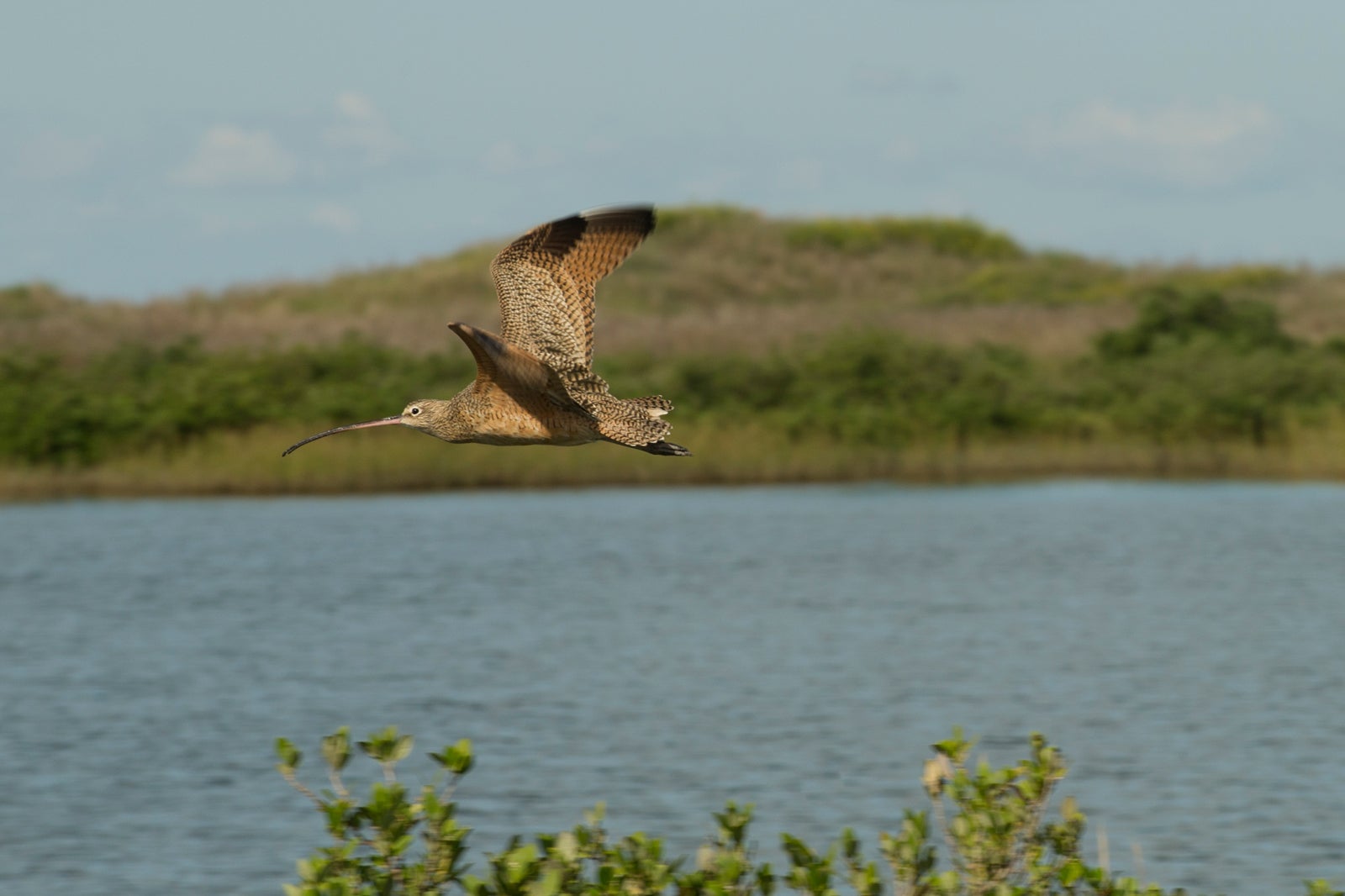Species Profile: Long-billed Curlew

The long-billed curlew is North America's largest shorebird. It breeds in the grasslands of the Great Plains and the Great Basin. Long-billed curlews weigh between 1 and 2 pounds (490 and 950 grams), have a wingspan of 24.4 to 35 inches (62 to 89 centimeters) and are around 2 feet (61 centimeters) tall. Their signature long, curved bill likely evolved to allow them to eat burrowing crabs and shrimp on their overwintering grounds.
Breeding
Long-billed curlews spend their summer breeding season in western North America where they live in prairies, pastures and agricultural fields. They can often be seen using their long bills to peck at the ground for the earthworms, grasshoppers, beetles and spiders that make up the bulk of their summer diet.
The curlews arrive on their breeding grounds in mid-March. Soon after their arrival, females and males begin building their nests together. Nest building starts with the male scraping the ground in several locations and the female choosing the location that she finds most suitable. The best nest sites are typically next to an object, such as a pile of rocks, a shrub or even a pile of cow manure.
Together, the pair of curlews dig a 20 centimeter wide, 7 centimeter deep depression in the ground that they then line with grass and other plant matter. The female lays four eggs in the nest. Both the male and female birds sit on the eggs to keep them warm. In about a month, the eggs will hatch.
The hatchlings are born with their eyes open and leave the nest after about five hours. Initially, both parents care for their young by teaching them to hunt for invertebrates, such as earthworms and crabs, around the nest site. Two to three weeks the chicks hatch, the female leaves and the male continues caring for the young. After one to one-and-a-half months, the young are able to fly away from their nest site. Adults and young spend the remainder of the breeding season apart, foraging in areas of tall grass and preparing for migration.
Overwintering
Long-billed curlews spend their winters along the Pacific, Gulf and southeastern coasts of the United States and in coastal and interior Mexico. Their habitat and diet can be quite different than it is during the breeding season. In the winter, they can be found mostly in wetlands, tidal estuaries, mudflats and flooded fields. Along the coast, their winter diet consists mostly of marine crustaceans and other marine invertebrates. The curlew’s long bill allows it to probe the sand and mud for deep-burrowing prey, such as shrimp and crabs.
Conserving the Curlew
The long-billed curlew is on the 2016 State of North America’s Birds Watch List, which lists the species most in danger of extinction without significant conservation efforts. Once abundant in North America, long-billed curlew populations declined in the late 1800s and early 1900s. At that time, curlews were seen as a game bird and were hunted in large numbers. Some restaurants even included long-billed curlews on their menus!
The Migratory Bird Treaty Act of 1916 made hunting curlews illegal, and many of the populations rebounded. Some populations, however, never recovered and many are currently decreasing. Populations at risk today include those that breed in the Great Plains of the United States and winter in eastern Mexico and along the southern coastlines of the United States.
Currently, the long-billed curlew’s biggest threat is a reduction in the high-quality grassland habitat that it needs for foraging and nesting. Millions of acres of grasslands in the United States have been lost due to fire suppression and human development. Fire suppression describes the act of putting out wildfires. Fire suppression can be important for human safety and to avoid property damage, but it can also cause grasslands, like those curlews depend on, to be overrun by forests and scrub habitats. One study found that a breeding population of curlews in Idaho increased by one-third in the year following a wildfire.
Agriculture has had one of the largest impacts on grassland habitat, due to the expansion of pasture and row crops in the Western and Midwestern United States. In addition to replacing grassland habitat with farmland, agriculture can have other negative impacts on migrating birds. For example, when farmers spray pesticides on crops, they may reduce food supplies for these migratory birds.
The decline of the long-billed curlew can only be stopped by taking measures to protect curlew habitat and food supplies during the breeding season. Scientists are currently tracking long-billed curlew to determine how they use the environment across their annual cycle. The results of these studies will help inform how we can best conserve this species.
Check out the following resources to learn more about long-billed curlew:
All About Birds: Long-billed Curlew
Audubon Guide to North American Birds: Long-billed Curlew
